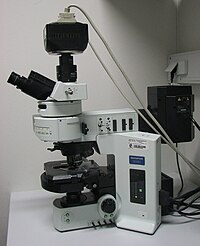Fluorescence microscope

A fluorescence microscope is a special kind of microscope that allows us to see tiny things like cells or really small particles in a different way. It works by using something called fluorescence, which is when certain things glow bright colors when light is shone on them.
Here's how it works:
First, scientists choose something they want to look at (like a cell or a tiny piece of a virus). They then put something called a fluorescent dye on it or inside it. This dye is like a magic ingredient that makes it glow a bright color when light shines on it.
Next, they put the sample (with the dye on it) into the microscope. The microscope shines a special kind of light on the sample that makes it glow really brightly. This light is usually blue, or sometimes green.
Then, the microscope uses special lenses to magnify the glowing sample. This means that it looks much bigger than it actually is, so scientists can see tiny details that they couldn't see before. They can even see things that are smaller than a human hair!
The cool thing about fluorescence microscopes is that they can make different parts of the sample glow different colors. This is really helpful, because it means that scientists can look at different parts of the sample separately. For example, they might make the cell nucleus (which is like the control center of the cell) glow blue, and make other parts of the cell glow red or green.
This lets scientists study how different parts of the sample are behaving, or how they're interacting with other parts. It's like shining different colors of light on a painting to see how the different colors mix together.
So that's what a fluorescence microscope does – it lets scientists see tiny things in a new way, by making them glow bright colors.
Here's how it works:
First, scientists choose something they want to look at (like a cell or a tiny piece of a virus). They then put something called a fluorescent dye on it or inside it. This dye is like a magic ingredient that makes it glow a bright color when light shines on it.
Next, they put the sample (with the dye on it) into the microscope. The microscope shines a special kind of light on the sample that makes it glow really brightly. This light is usually blue, or sometimes green.
Then, the microscope uses special lenses to magnify the glowing sample. This means that it looks much bigger than it actually is, so scientists can see tiny details that they couldn't see before. They can even see things that are smaller than a human hair!
The cool thing about fluorescence microscopes is that they can make different parts of the sample glow different colors. This is really helpful, because it means that scientists can look at different parts of the sample separately. For example, they might make the cell nucleus (which is like the control center of the cell) glow blue, and make other parts of the cell glow red or green.
This lets scientists study how different parts of the sample are behaving, or how they're interacting with other parts. It's like shining different colors of light on a painting to see how the different colors mix together.
So that's what a fluorescence microscope does – it lets scientists see tiny things in a new way, by making them glow bright colors.
Related topics others have asked about:
